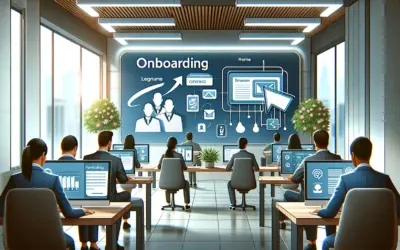The Rise of Telecommuting: Understanding Its Impact in the Metaverse Era
As we embrace a new horizon in the digital workplace, telecommuting has surged to the forefront as a leading trend in the professional landscape. This shift has been significantly accelerated by the global pandemic, leading to a reevaluation of traditional office settings. With the rise of the Metaverse, a collective virtual shared space, the implications for remote work have reached new, unprecedented levels. Understanding how telecommuting has evolved within the Metaverse era is crucial for both employers and employees navigating this brave new world.
Integration of Virtual Reality in Remote Work Environments
In the Metaverse era, the embodiment of a virtual space where avatars interact is redefining the boundaries of ‘office’ environments. Virtual reality (VR) tools are instrumental in facilitating immersive meetings and collaborative projects. As a result, telecommuting is no longer just about offsite work; it’s about fostering a virtual presence that can simulate the nuances of in-person interactions.
Benefits of a VR-Enhanced Workplace
- Increase in employee engagement through gamified experiences.
- Promotion of a balanced work-life by eliminating the need for commutes.
- Opportunities for global talent recruitment without geographical barriers.
Challenges and Considerations
- Ensuring equal access to VR technology for all employees.
- Adjusting management strategies to suit virtual teams.
- Addressing potential VR-induced health issues such as eye strain or motion sickness.
Socio-Economic Implications of Telecommuting in the Metaverse
Telecommuting’s expansion within the virtual realms of the Metaverse has a far-reaching socio-economic impact. On one hand, businesses benefit from reduced overhead costs associated with physical office spaces and utilities. On the other hand, the ability to work remotely contributes to a more diversified workforce, as people from different socio-economic backgrounds are now afforded the same employment opportunities without the need for costly relocations.
Positive Economic Impact
- Diminished need for large-scale corporate infrastructures.
- Increased savings for employers and employees alike.
- Boosted productivity through personalized virtual workstations.
Social Considerations
- Promotion of work-life balance resulting in higher job satisfaction.
- Creation of inclusive workplaces for individuals with disabilities.
- Growing importance of digital literacy across all levels of society.
Future Outlook of Telecommuting and the Metaverse
Contemplating the trajectory of telecommuting within the Metaverse, it’s clear that we are on the cusp of a revolution in how we define work. As this trend progresses, we must adapt to new technologies and consider their implications for workforce dynamics ethically and sustainably. The expansion of the Metaverse and its integration with telecommuting presents an exhilarating opportunity to reshape the professional landscape in a way that prioritizes flexibility and innovation.
Leveraging Tech for Sustainable Growth
- Investment in robust cybersecurity to protect virtual workspaces.
- Persistent upskilling and digital training for the evolving job market.
- Consideration of ecological impacts of data centers powering the Metaverse.
Embracing a Collaborative Approach
- Encouraging cooperation between tech developers, businesses, and workers.
- Fostering global think tanks to address potential regulatory frameworks.
- Ensuring that advances in telecommuting technology are accessible to all.
By embracing the tenets of flexibility, inclusivity, and collaboration, the rise of telecommuting in the Metaverse era heralds a new chapter in the digital revolution. As we pivot towards these novel models of work, it is incumbent upon us to strike a balance between technological progress and the preservation of human connection in the workplace.
How the Metaverse is Revolutionizing Remote Work: Telecommuting Trends to Watch
The rise of the Metaverse is changing the domain of remote work in unprecedented ways. With advancements in virtual reality (VR) and augmented reality (AR), the concept of telecommuting is undergoing a transformation that is shaping the future of work. These developments are not just altering the way we think about workspaces, but are also creating new opportunities and challenges for employers and employees alike.
Virtual Workspaces and Immersive Collaboration
In the realm of the Metaverse, virtual workspaces are now more than a novelty; they’re becoming essential tools for collaboration. Immersive environments are allowing teams to interact in real-time, just as if they were in a physical office. This is particularly significant for jobs requiring close collaborative efforts. Through the use of VR headsets and AR glasses, employees can engage visually and spatially with colleagues, leading to a more integrated and interactive experience. This not only makes remote meetings more engaging but can also enhance creativity and teamwork.
Enhancing Remote Work with Digital Avatars
Digital avatars are another trend within the Metaverse that are redefining remote interactions. Instead of static profile pictures or video feeds, avatars allow individuals to present themselves in a personalized and dynamic manner. This helps maintain a sense of presence and can reduce the isolation often associated with remote work. Furthermore, avatars can transcend physical limitations, offering inclusive options for individuals to represent themselves as they feel most comfortable.
Meeting the Challenges of Connectivity and Accessibility
- Ensuring Stable Internet Access: As the Metaverse becomes central to telecommuting, having a stable and fast internet connection is more critical than ever. Remote workers need to be mindful of the technical requirements to operate efficiently within these virtual spaces.
- Overcoming Hardware Limitations: High-quality VR and AR experiences require specific hardware, which might not be readily available to everyone. Businesses and individuals must consider the costs of equipping their teams with the necessary technology.
- Addressing Privacy and Security: With the Metaverse comes the increased need for robust cybersecurity measures to protect sensitive data and ensure privacy within virtual environments.
The continued evolution of the Metaverse is paving the way for a new era of remote work, bringing both exciting prospects and notable challenges. As telecommuting becomes more immersive, it is clear that the traditional boundaries of the workplace are being redrawn. The time is ripe for businesses and remote professionals to embrace these trends and adapt to the dynamic landscape of the virtual work world.
Maximizing Productivity: Tools and Strategies for Telecommuting in the Metaverse
Welcome to the future of work! Telecommuting in the Metaverse is transforming the way we approach our professional lives. As we navigate this exciting new virtual space, being equipped with the right tools and strategies is essential for maximizing productivity. This article will guide you through setting up your digital workspace, selecting the best tools, and adopting strategies that’ll keep you focused and efficient in a world where the lines between physical and virtual are increasingly blurred.
Setting Up Your Virtual Workspace
Creating an inspiring and functional virtual workspace in the Metaverse is the first step in fostering productivity. Select a platform that aligns with your work needs—whether it’s one that offers ample customization options or one that mimics a traditional office setup. Make sure your virtual space has minimal distractions and a layout that promotes workflow efficiency.
Ergonomics for the Digital Age
Even in a digital workspace, ergonomics play a crucial role. Ensure that your physical setup – which includes your desk, chair, and computer peripherals – supports proper posture and reduces strain. High-quality VR headsets and controllers that are comfortable for long sessions are equally important.
Staying Organized
Organization is pivotal. Utilize virtual tools for keeping your space clutter-free and your tasks in check. Features like virtual boards and file management systems can mirror their real-world counterparts and enhance the sense of control over your digital environment.
Productivity Tools for the Metaverse
Telecommuting thrives on communication. Invest in reliable virtual communication tools that provide clear audio and video quality. These tools should facilitate effortless collaboration with colleagues, no matter where they are in the physical world. Look for platforms that integrate seamlessly with other productivity apps you use.
Project Management Software
Staying on top of tasks is paramount when working remotely. Project management software in the Metaverse should offer a user-friendly interface and the ability to track progress, assign tasks, set reminders, and create deadlines. This keeps everyone on the same page and ensures that projects move forward as planned.
Time Management Apps
In the realm of virtual work, maintaining a healthy work-life balance is key. Use time management apps to schedule your tasks, set work hours, and make time for breaks. These tools can help prevent burnout and ensure that you remain focused and motivated throughout your workday.
Strategies for Staying Focused and Efficient
A consistent routine is invaluable for telecommuting success. Start your day with a set ritual to signal the beginning of the workday, even if commuting only involves strapping on a VR headset. Regular start times, break times, and end times provide structure and help keep you disciplined.
Managing Distractions
While the Metaverse can be immersive, real-world distractions can still interrupt. Be proactive and establish a quiet, dedicated workspace if possible. Inform your household of your working hours and consider using noise-cancelling headphones to maintain focus on your tasks within the virtual world.
Wellness and Self-care
Never underestimate the importance of wellness and self-care when telecommuting. Regularly unplug from the Metaverse to rest your eyes and mind. Physical exercise, healthy eating, and social interactions outside the virtual world are all critical to ensuring that you can return to your virtual workspace refreshed and ready to be productive.
Embracing telecommuting in the Metaverse with the right tools and strategies can vastly improve your productivity and overall work experience. By setting up an efficient workspace, harnessing the best productivity tools, and adhering to proven strategies, you’ll be well on your way to thriving in this new digital frontier.
Telecommuting Challenges and Opportunities in the Metaverse Environment
The shift to digital has ushered in innovative ways to work remotely, with the metaverse environment offering an immersive platform for telecommuting. However, this transition is not without its challenges. One primary hurdle is the technological barrier to entry. Required are high-speed internet connections and powerful computing hardware to access sophisticated virtual spaces, which may not be accessible to all employees. Ensuring cybersecurity within the metaverse also poses a quandary, with concerns about data privacy and the potential for virtual harassment necessitating robust security measures.
Adapting to Virtual Collaboration
Adapting traditional work processes to suit the metaverse environment remains a challenge. The absence of non-verbal cues can affect communication efficacy, while employees must adapt to virtual collaboration tools and methodologies. Virtual reality (VR) training programs and augmented reality (AR) workshops are imperative to bridge the skills gap and alleviate the steep learning curve associated with these novel technologies.
Ensuring Inclusivity and Accessibility
A crucial concern is ensuring that the metaverse is inclusive and accessible to people with disabilities. Navigation within the virtual spaces must be intuitive and accommodate various needs to avoid exclusion. Additionally, the risk of experiencing techno-stress and the blurring of work-life boundaries must be mitigated through careful design and sensible usage policies.
Opportunities in the Metaverse Environment
Fostering Creativity and Innovation
The metaverse presents unique opportunities for creativity and innovation in telecommuting. In this expansive digital realm, employees have access to 3D visualization tools and collaborative spaces that transcend physical limitations. This enables the conception of complex projects and fosters a culture of innovation, as team members collaborate across virtual workrooms and experiment with new ideas in ways that traditional environments may not permit.
Enhanced Learning and Development
Another opportunity lies in enhanced learning and professional development. The metaverse provides an arena for immersive learning experiences, where employees can engage with interactive training modules and role-play scenarios that improve skill retention and job performance. Furthermore, the accessibility to a global pool of resources and experts allows for continuous education, fostering a culture of lifelong learning.
Global Collaboration and Networking
The metaverse removes geographic barriers, enabling global collaboration and networking at an unprecedented scale. Employees can connect with peers from around the world in real time, facilitating diversity of thought and access to a wider range of business opportunities. This boundary-less environment merges different cultures and viewpoints, leading to more innovative outcomes and a broader understanding of global markets.
In summary, while telecommuting in the metaverse environment presents distinct challenges, the opportunities it provides have the potential to revolutionize remote work. From breaking down geographical barriers to enabling innovative ways of collaboration and learning, the metaverse holds the promise of shaping the future of how we work and interact within digital landscapes. Balancing these challenges and opportunities is critical for organizations looking to embrace the full potential of telecommuting in the metaverse.
Future-Proofing Your Career: Skills for Effective Telecommuting in the Metaverse
In the burgeoning era of the Metaverse, the ability to navigate and use virtual collaboration platforms is indispensable. With telecommuting becoming the norm, tools such as virtual reality (VR) meeting spaces and augmented reality (AR) project management apps allow employees to immerse themselves in a digital environment that simulates the office space. To thrive, one must be adept at maneuvering these virtual realms, ensuring connectivity and engagement without the benefit of physical presence.
Moreover, understanding the etiquette and functionality of various platforms is crucial. This means getting comfortable with the unique features and interfaces of tools like holographic video conferences, virtual whiteboards, and collaborative coding environments. Developing a familiarity with these tools will not only enhance your productivity but also signify your adaptability to future work demands.
Key Platforms to Master:
- VR Meeting Spaces (e.g., Spatial, AltspaceVR)
- AR Project Management Tools (e.g., Asana’s AR features)
- Holographic Communication Technologies
- AI-driven Task Automation Software
Building a Strong Virtual Presence
In a world where physical interactions are limited, your virtual presence becomes your new handshake. Cultivating a strong personal brand within the Metaverse is key to building professional relationships and opportunities. This means being active and professional on relevant virtual platforms, contributing to discussions, and showcasing your expertise in immersive environments.
An effective virtual presence is characterized by clarity in communication, responsiveness, and consistent engagement. Networking in the Metaverse requires a strategic approach to visibility and collaboration, ensuring that you are a memorable and reliable participant in virtual spaces.
Crafting a Compelling Virtual Identity:
- Develop a professional and authentic avatar
- Engage actively in industry-specific virtual events
- Create and share immersive content relevant to your field
Adapting to New Forms of Communication
As the Metaverse blurs the lines between the physical and digital worlds, communication adaptability is essential. This doesn’t simply mean conveying your message, but also understanding and interpreting non-verbal cues within VR and AR environments. Effective telecommuting requires one to be social-savvy, attuned to the nuances of digital body language, and versed in various emerging communication protocols.
Successful communicators in the Metaverse will be those who can express empathy and build rapport through a screen. They will be the ones who effortlessly shift from text-based chats to voice calls, and from video conferencing to full immersion in VR meetings, always maintaining clarity and personability no matter the medium.
Enhancing Communication Skills:
- Practice active listening and clear articulation in VR environments
- Learn to read and utilize digital body language
- Develop cross-cultural communication competencies for global interactions
Leveraging Data Security and Privacy Measures
In the Metaverse, where data is the most valuable currency, knowledge of cybersecurity protocols is non-negotiable. Telecommuting roles will increasingly require employees to be vigilant in protecting sensitive information. Understanding and implementing advanced security measures to safeguard both personal and corporate data is a key skill set.
Effective telecommuters must familiarize themselves with the latest cybersecurity tools and best practices. Encryption, secure access controls, and awareness of potential threats are just the starting point. Cultivating a mindset of continual learning in this rapidly evolving field will protect both your career and the interests of your team or organization.
Security Skills to Acquire:
- Data Encryption Techniques and Tools
- Two-Factor Authentication Processes
- Regular Updating and Patching of Software
- Continuous Cybersecurity Education













0 comentarios